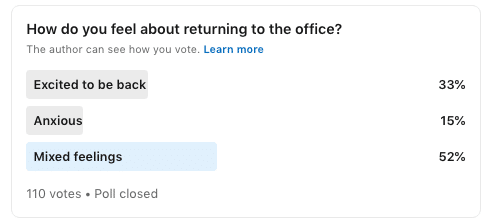Return to the office: Three tips for managing your mental health
Returning to work after any absence always comes with some nerves. Due to the COVID-19 pandemic, many employees have been working remotely from home for the best part of a year. Now, as they return to office life in the ‘new normal’ many of those back-to-work anxieties will be the same as after a period of prolonged absence.
For many, returning to the office feels like a big change after months working at home and seeing only a small circle of people. Excitement, anxiety – or a mix of both – these are all valid emotions and the majority of employees (52%) that we asked declared that they had mixed feelings about returning to work.
While employees have missed their colleagues (and the fancy coffee machine!), working from home has offered the perks of no long commutes and having a better work-life balance. This new change means that managing stress and anxiety will be essential over the weeks and months to come. You may find yourself having worries about keeping yourself safe while at your workplace or find yourself struggling emotionally with the change of routine.
For those employees who have worked throughout the pandemic, holding down the fort in a sparsely populated workplace, this sudden influx of people will feel like a big change too. Bringing with it adjustments in schedule, employee rotations and social distancing measures.
With all this in mind, in this blog we offer our top three tips for managing your mental health now that you are back in the workplace.
Communicate
It’s true that communication really is key in so many aspects of business and in life. If you are feeling uncertain, anxious or struggling with your mood then the first thing you need to do is talk about it. Talk to your managers, co-workers, family and friends. Let them know how you are feeling and talk about your concerns. Mental health charity Mind recommends speaking with a manager about your worries: “It might help to talk often about how you’re getting on. Let them know what you’re finding helpful or difficult.”
Don’t be afraid to state your feelings clearly. This is especially true if you are wearing a face mask while at work – you’ll need to communicate verbally more than you would normally.
Seek support
Your team is there to support you. Arrange regular catch-ups with your manager; share wellbeing goals and let them know how they can support you.
Additional support is always available; if you need to, be sure to access mental health resources or any workplace initiatives or services offered by your company. Your HR team should be able to advise you if you are unsure of how to access these.
If these resources aren’t in place then take a look at some of the links at the bottom of this page for where you can access outside support.
Look after yourself
When you’re busy or feeling stressed, it’s easy to forget to practice self care. This is an important factor in managing stress and mental health though, so it’s so important to make time to look after yourself. There are many ways you can do this both during the workday and at home.
Mindfulness is recommended by health practitioners and mental health charities as a great way to reduce stress. Find a soothing activity that you can do on your commute or at points throughout your work day. This could be taking a walk, creating a playlist for your commute, stopping to drink a soothing warm drink or concentrating on your breath.
Remember to focus on the positives; back in the workplace you have your colleagues around, are free from the distractions of home and have a clearer boundary between home and work. Bring in those parts of your routine that you enjoyed about working from home; whether it’s making time to eat a healthy lunch or taking a walk on your break or after work.
Useful links:
- Mind
- For Employers: SOM’s Returning to the workplace COVID-19 Toolkit
- Mental Health Foundation
Our consultants are here to support you in your return to the office and are always happy to provide help and advice no matter what your situation. If you would like to talk then then get in touch.


